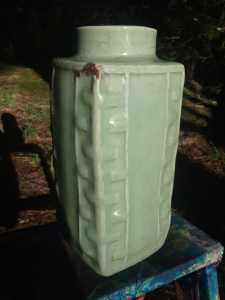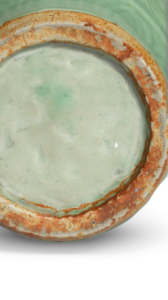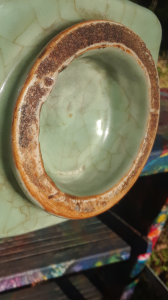The Chinese and Asian Art Forum. For Fans, Collectors and Dealers.
 Basic Rules For the BidAmount Asian Art Forum: Talk about whatever you want. You can even discuss and offer things that are for sale if they are authentic. Maximum image file size per post is 2 MB. Images of 700pxl x 700pxl are optimal if saved at a medium resolution. Be respectful of others and enjoy yourself. Click the YouTube link for a brief tutorial on using the forum. You can also EMBED Videos by cutting and pasting from You-Tube, Vimeo etc.
Basic Rules For the BidAmount Asian Art Forum: Talk about whatever you want. You can even discuss and offer things that are for sale if they are authentic. Maximum image file size per post is 2 MB. Images of 700pxl x 700pxl are optimal if saved at a medium resolution. Be respectful of others and enjoy yourself. Click the YouTube link for a brief tutorial on using the forum. You can also EMBED Videos by cutting and pasting from You-Tube, Vimeo etc.
NOTE: To post an item or add a new post, click open the category title from the FORUM LIST, and CLICK the Blue ADD TOPIC button.
Collapsed Longquan were sometimes preserved even untill this day for our appreciation like this bamboo vase sold at Christie's.
http://www.alaintruong.com/archives/2017/08/07/35558517.html
The typical Longquan Cong vase looks somewhat different than the one posted by the OP'er. More like this one also from Christie's.
http://www.alaintruong.com/archives/2019/12/25/37891199.html
But otherwise an interesting vase. I've never seen one like that before.
@lotusblack see lot 195 in the Augutte's catalogue, 19th century brown cong with similar pattern. I saw a completely collapsed celadon vase somewhere in a sale but can't remember which sale.
@greeno107 thank you for your opinion and your response really appreciate it. Think there is a argument for either side. Prob could sway more on the side of fake/reproduction just based on your points. Makes logical sense to me and agree with you. That being said think there is always exceptions to the rules. Thanks again!!!
The David Percival vases, made during the Yuan dynasty (likely a good 200 years prior to the proposed dating of your piece) stand at just over 2 feet tall, and only one of the two vases has a slight tilt.
The comparison between your 9 1/2” tall vase that leans at a degree that prevents it from standing requires one to close both eyes… it is wishful thinking at best.
The example of the Song vase, which only flaw is the fusion of the broken mouth piece to its neck, is otherwise masterful in every regard. And, as the vase was intended for export to Japan, who culturally do not find such imperfections entirely disqualify, the piece was not destroyed- just read the history given in the link.
So, are we to conclude your vase is of such extraordinary quality, exported to Japan, and ever since was treasured by Japanese collectors?
Do you have any evidence to support such an unlikely scenario?
Situations like this are by and far, remote exceptions. Exceedingly rare circumstances that they should not be used as a measurement of authenticity.
Yet here we are, using these most improbable examples as if they should be the common mark to which all porcelains should be measured. It is folly, and this continuous lowering of the bar on standards is disheartening.
It is not simply about differences in opinion, but speaks of a growing desire to expand the scope of collecting to include objects that display a remote similarity to the genuine article, and disguise the faults by adding man made flaws to implant the notion ‘why would someone make a fake with such a flaw?’, which is followed quickly with the false conclusion - ‘it must be genuine.’
My experience is that the motives behind such acts are driven mostly by monetary gain by collectors whom have filled their houses with fakes, and hope one day to sell them as genuine.
If you wish to build your knowledge and collection around such nonsense, that’s your choice, but I do not think it will best fruit regardless of how much time passes.
@lucky_sun123 lot 195 in Augutte's catalogue is listed as sang de boeuf, seems brown in the photo, what makes your vase look somewhat different is perhaps more space between the transepts on the sides?
P.S. I think David's idea of using a stand to straighten is a good one, maybe just use the time honored tradition of carpenters, shem it up on one side. I like the cong with trigrams all across the front, amazing that such old designs look so modern.
@greeno107 the collection this came out of was previously owned by a very, very wealthy family, who lives on a very small island with a population of about 3500 year around residence. The antique store I frequent and got this from did a estate sale for the family and items they wished to sell. The owner of the antique store only sells local island items and has been in biz for 35 years.
@lucky_sun123 There is hardly a collector that hasn’t been told a tall tale by a friendly antique shop owner.
And by rare chance the story told is entirely true, why did they sell the case for only $45?
Wouldn’t such a rare treasure be with a few hundred or thousand dollars?
Look - I’ve put my thoughts out there for you to consider, or not.
If you think your piece is genuine, a slanted cong vase of such high quality that despite the tilt, it was collected and cared for over the past 400 years so that you could buy it from an antique shop for only $45, who also provided you with verbal provenance that it came from a very very wealthy island dwelling family…. well, congratulations!
Pardon my skepticism.
@greeno107 I appreciate the consideration and your time and opinion. Your points are fair and just I value them and consider them to prob be true. Yes you are correct many antique shops have similar fables of distorted truth etc. More likely after a quick internet search and unfamiliar with the style she listed it as such old vase? Anyways thank you again!!
@greeno107 some of these Ming repros are sort of funky. I don't know about this.
https://www.christies.com/en/lot/lot-6221031
@lotusblack is correct.
@rahawkins I followed the link you posted... Did I miss something? I did not see a vessel that had completely collapse on itself, cong vase or otherwise.
So, what is Brian 'correct' about? That imperfect pieces were produced in the Ming? Or, that this cong vase is Ming?
Read my 3rd post to this thread -
A firing crack, or faulty glaze, or a minor collapse resulting in a slight tilt on export wares and minyao (common domestic wares) might be explainable because the standard of quality would be fairly low.
However, objects made for upper society were done by commission, they were expensive, the standard were extremely strict, and a kiln’s reputation would be put into question for failing to deliver an exemplary piece.
I am not saying that Ming pieces never sagged, cracked, or otherwise came out from the kiln imperfect. I'm saying THIS VASE, due to primarily its massive imperfection, is a fake, because a cong vase would never left a Ming kiln with such significant deformity.
It is very important to take into context the type of vessel when considering authenticity, and as such, during the Ming (and even later), the cong vase would have been considered of high cultural importance, a bond of heaven and earth ( https://gotheborg.com/glossary/cong.shtml).
Since we've come this far, let's look at the overall quality of the glaze and construction:
Here is an example from Christie's dated to Song/Yuan (as there were no examples on Christie's or Sotheby's of a Ming cong vase - which may not be coincidence) next to the subject vase (both are about the same size):
The neck is too long, the design lacks any sophistication, the body seems to bloat, the color is diluted and has crackle (as if guan ware), and (regardelss of the difference in design which is problematic) the carving overall lacks the crispness that is associated with jade congs of which this vase is modelled.
So, I ask you... Is this a Ming/Yuan/Song vase that just collapsed, but otherwise of the high quality and standards of form expected of longquan wares of that period?
Please, say no. Please, say no. Please, say no.
Anyway....
When Christie's puts on their catalog cover a porcelain of similar deformity, I guess I'll eat my words. A thousand pardons for my stubbornness.
@lotusblack So, Brian.... turnabout is fair play, right?
I've stated my positon. What are the criterias that you used to base your statement?
It looks like a good Longquan piece from the Ming period but collapsed during the firing. What is unusual is I read they would have destroyed such a piece but it looks ok and I see no issue with it.
What makes this a 'good longquan piece from the Ming'?
What aspects of the vase 'look ok', and why do you really have 'no issue with it'?
Thanks for visiting "The BidAmount Asian Art Forum | Chinese Art"
If you sell on eBay, or have a shop feel free to post images and descriptions and links.
Check back often for discussion about the latest news in the Chinese art and antique world. Also find out about the latest Asian art auctions at Sotheby's, Christie's, Bonhams and Tajans.
Auction results for: fine porcelain, ceramics, bronze, jade, textiles and scholar's objects. As well as Japanese, Thai, Vietnamese and other Asian cultures.
Thank you,
Peter Combs
Topics and categories on The BidAmount Asian Art Forum | Chinese Art
Kangxi vases, Kangxi dishes and chargers, Kangxi ritual pieces, Kangxi scholar's objects, Qianlong famille rose, Qianlong enamels, Qianlong period paintings, Qianlong Emporer's court, Fine porcelain of the Yongzheng period. Chinese imperial art, Ming porcelain including Jiajing, Wanli, Xuande, Chenghua as well as Ming jades and bronzes.
The BidAmount Asian Art Forum | Chinese Art
A free Asian art discussion board and Asian art message board for dealers and collectors of art and antiques from China, Japan, Korea, Thailand, Cambodia, Vietnam and the rest of Asia. Linked to all of the BidAmount Asian art reference areas, with videos from plcombs Asian Art and Bidamount on YouTube. Sign up also for the weekly BidAmount newsletter and catalogs of active eBay listing of Chinese porcelain, bronze, jades, robes, and paintings.
The art of calligraphy - and for the ancient Chinese it certainly was an art - aimed to demonstrate superior control and skill using brush and ink. Calligraphy established itself as one of the major Chinese art forms during the Han dynasty (206 BCE - 220 CE), and for two millennia after, all educated men were expected to be proficient at it.
The Museum’s collections of Asian art span nearly five millennia and encompass the cultures of China, the Himalayas, India, Japan, Korea, and Southeast Asia. In 2007, the Museum launched an initiative to create dedicated galleries for the collection, beginning with a gallery for the arts of Korea ...
Chinese art is full of symbolism, in that artists typically seek to depict some aspect of a totality of which they are intuitively aware.
China Online Museum is the finest online museum of Chinese art. It features Chinese calligraphy, painting, ceramics, bronzes, carving, and other artworks.
Chinese Ceramics & Works of Art. Overview Upcoming auctions Contacts Auction results ... Christie’s sales of Chinese ceramics and works of art showcase centuries of Chinese history. Held throughout the year in London, New York, Paris and Hong Kong, they attract a wide audience of collectors and connoisseurs vying for pieces as diverse as ...
Explore Asian Art Week. Contact the Specialist Department. Chinese Paintings ... Senior Specialist, Head of Sale. [email protected]. Tel:+1 212 641 5760. Bid in-person or online for the upcoming auction:Fine Chinese Paintings on 10 September 2019 at New York. Bid in-person or online for the upcoming auction:Fine Chinese Paintings on 10 ...
Discover an abundance of must-see art from all corners of a vast continent at Christie’s NY Asian Art Week. From contemporary classical and Chinese paintings to works with exemplary provenance from the Art Institute of Chicago, our Rockefeller Paza galleries will be full of ancient treasures and contemporary masterworks in a salute to the vibrant arts of Asia.
Sold to benefit The Art Institute of Chicago’s Asian Art Acquisition Fund, the sale features 84 lots with a focus on Ming and Qing porcelains, and offers a rare insight into the taste for collecting Chinese ceramics and works of art in the Midwest from the end of the 19th century through the 1980s. Highlights include two Wanli wucai garlic-head vases, a Qianlong mark and period, blue and ...
Specialist, Chinese Paintings, Christie's London Dr Malcolm McNeill is a Specialist in Chinese Paintings at Christie’s, based in London. He previously worked as an assistant curator of the Chinese collections and the Victoria and Albert Museum in London, as a researcher at the British Museum, and as a translator and tour guide at the National Palace Museum in Taipei.
The Christie's Education 2020 Conference: The Chinese Art Market 18 Jun 2019 Christie’s Education is delighted to announce our first international academic conference in Asia which will take place in Hong Kong from 26-27 November 2020 at the Hong Kong Convention and Exhibition Centre and will run in parallel with Christie’s Hong Kong Autumn Auctions.
The summer Chinese Art sale in Hong Kong will feature works of art from several private collections, including Qing porcelains and textile from the collection of the legendary Chinese art dealer A. W. Bahr (1877–1959), fine gilt bronze Buddhist sculptures from an old Hong Kong collection, an East Asian collection of Qing dynasty wine cups and jades, and a Japanese collection of Song ceramics ...
Sotheby's Chinese Works of Art Department holds two auctions each year in London, New York, Hong Kong and Paris.
Chinese Art - View Auction details, bid, buy and collect the various artworks at Sothebys Art Auction House.
With more than 340 Chinese works of art dating from the Neolithic to the Republic periods, highlights of this sale include a selection of Qing Imperial monochromes from the collection of Arnold and Blema Steinberg, early ceramics from the Art Institute of Chicago and Chinese porcelain and works of art from the collection of Henry Arnhold.
Results: Sotheby's Asia Week achieved $52.4 million in six strong auctions, exceeding pre-sale estimates. With 76.5% of lots sold and 60.3% of lots surpassing high estimates, the Asian art sales at Sotheby's indicate continued collector interest in the finest works of art from China, India and and the Himalayas.
Today's sale of Important Chinese Art will proceed as planned with sessions at 10 AM and 2 PM EDT. Sotheby's will be monitoring the weather conditions throughout the day and will be available to coordinate alternative bidding options should conditions make it difficult for clients to attend the auction in person.
Bonhams Chinese Art department is renowned for offering the finest works of art representing the richness and breadth of China's artistic heritage, particularly Imperial porcelain, white and spinach green jades, cloisonné and Buddhist art. Specialised international auctions are held globally, including London, Hong Kong and San Francisco.
Bonhams : Chinese Works of Art We use cookies to remember choices you make on functionality and personal features to enhance your experience to our site. By continuing to use our site you consent to the use of cookies. Please refer to our privacy and cookie policies for more information.
Bonhams Fine Art Auctioneers & Valuers: auctioneers of art, pictures, collectables and motor cars. We use cookies to remember choices you make on functionality and personal features to enhance your experience to our site. By continuing to use our site you consent to the use of cookies. ... Chinese Art (US) General enquiries
Bonhams : Fine Chinese Art We use cookies to remember choices you make on functionality and personal features to enhance your experience to our site. By continuing to use our site you consent to the use of cookies. Please refer to our privacy and cookie policies for more information.
Bonhams Fine Art Auctioneers & Valuers: auctioneers of art, pictures, collectables and motor cars Bonhams : Asian Art We use cookies to remember choices you make on functionality and personal features to enhance your experience to our site.
Bonhams are international auctioneers of fine Chinese and Japanese art. We specialise in rare Imperial and Export Chinese ceramics and works of art, as well as Japanese ceramics, fine and decorative works of art from the Neolithic Period to the 20th century. View on map
Bonhams Fine Art Auctioneers & Valuers: auctioneers of art, pictures, collectables and motor cars. We use cookies to remember choices you make on functionality and personal features to enhance your experience to our site. By continuing to use our site you consent to the use of cookies. ... Asian Art Bonhams. Work. 22 Queen St.




